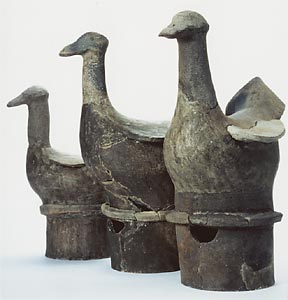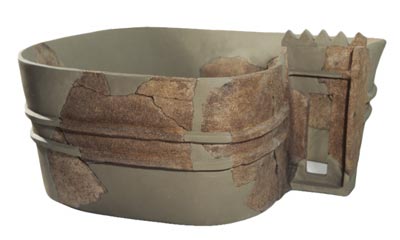Suyama:
A graveled slope placed on an artificial island in the manner of a pebbled beach in a Japanese garden, a gourd-shaped island, waterfowl-shaped ceramic figurinesc A large-scale keyhole-shaped mounded tomb given color with an array of devices.

Bird's-eye view of Suyama tomb
|

Head of a ceramic waterfowl figurine, in situ
|

Artificial island (from the northwest)
|

Ceramic waterfowl figurines The two items on the right stand approximately 60 cm tall, and the one on the left is about 45 cm. They are thought to have been made as realistic imitations of flat-beaked whistling swans. The differences in size are thought to indicate a male, a female, and a juvenile, and the lack of depiction of the legs suggests they were represented as floating in the water. (photo by Satō Ubun) |

|

|

|

|
Suyama Tomb, Kōryō Town, Nara Prefecture
The largest class of tomb in the Umami tomb group
Suyama tomb is a colossal keyhole-shaped mound from the initial part of the Middle Kofun period, located in the Kōryō district in the western part of the Nara basin. At 220 meters in length, it is the largest-scaled mound among the many large tombs of the fourth and fifth centuries in the Umami tomb group, and is designated a special historic site. It has square projections on the right and left sides at its constricted portion, the shield-shaped moat surrounding the mound is filled with water, and the outer rampart of the moat is well preserved.
Two vertical stone chambers have been identified in the round portion of the mound, and there is record of a small stone chamber existing in the rectangular portion as well. Items plundered from the tomb in the Meiji period are in the possession of the Imperial Household Agency's Archives and Mausolea Department, with the following items verified: 4 or more hoe-shaped, 3 wheel-shaped, and 1 ring-shaped steatite bracelets; 1 large and 35 smaller steatite comma-shaped beads; 63 cylindrical and 3 barrel-shaped beads; 2 steatite knife replicas.
An unusual gourd-shaped stone arrangement
During an excavation conducted in conjunction with measures taken in fiscal year 2003 for public presentation of the site, a feature in the shape of an artificial island was discovered. The island jutted into the moat, connected to the western side of the rectangular portion of the mound by a narrow land bridge, and was 1.5 m high and rectangular in form at 16 m length north-south by 12 m east-west, with projections extending from its two western corners. The sloping western face between the two projections was paved with gravel in the same manner as an artificial pebble beach made in a Japanese garden. Large flat stones had been placed upright at the island's four corners. Also, white gravel had been spread on the upper surface of the island, and representational haniwa (ceramic funerary sculptures) had apparently been arranged there, with items in the following shapes recovered: sunshade (7), house (7), shield (3), waterfowl (3), enclosure (4), fence (10 or more). In addition, to the west of the island a gourd-shaped stone arrangement 8 m in length was discovered within the moat. It is thought to have stood in the water as a gourd-shaped island. Both the artificial island and gourd-shaped stone arrangement are exceedingly rare, and serve as new clues for understanding large-scaled mounded tombs of the initial part of the Middle Kofun period. (Inoue Yoshimitsu)
